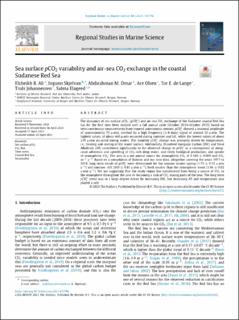| dc.contributor.author | Ali, Elsheikh B. | |
| dc.contributor.author | Skjelvan, Ingunn | |
| dc.contributor.author | Omar, Abdirahman | |
| dc.contributor.author | Olsen, Are | |
| dc.contributor.author | De Lange, Tor | |
| dc.contributor.author | Johannessen, Truls | |
| dc.contributor.author | Elageed, Salma | |
| dc.date.accessioned | 2022-04-26T07:54:13Z | |
| dc.date.available | 2022-04-26T07:54:13Z | |
| dc.date.created | 2021-05-12T12:00:56Z | |
| dc.date.issued | 2021 | |
| dc.identifier.issn | 2352-4855 | |
| dc.identifier.uri | https://hdl.handle.net/11250/2992698 | |
| dc.description.abstract | The dynamics of sea surface pCO2 (pCO2w) and air–sea CO2 exchange of the Sudanese coastal Red Sea has for the first time been studied over a full annual cycle (October 2014–October 2015) based on semi-continuous measurements from moored autonomous sensors. pCO2w showed a seasonal amplitude of approximately 70 μatm, overlaid by a high frequency (3-4 days) signal of around 10 μatm. The highest values, of about 440 μatm occurred during summer and fall, while the lowest values of about 370 μatm occurred during winter. The monthly pCO2w change was primarily driven by temperature, i.e., heating and cooling of the water surface. Additionally, Dissolved Inorganic Carbon (DIC) and Total Alkalinity (AT) contributed significantly to the observed change in pCO2w as a consequence of along-coast advection and upwelling of CO2-rich deep water, and likely biological production, and uptake of atmospheric CO2. The area is a net annual source for atmospheric CO2 of 0.180 ± 0.009 mol CO2 m−2 y−1. Based on a compilation of historic and our new data, altogether covering the years 1977 to 2015, long term trends of pCO2w were determined for the seasons winter–spring (1.75 ± 0.72 μatm y−1) and summer -fall (180 ± 0.41 μatm y−1), both weaker than the atmospheric trend (1.96 ± 0.02 μatm y−1). We are suggesting that the study region has transformed from being a source of CO2 to the atmosphere throughout the year to becoming a sink of CO2 during parts of the year. The long term pCO2w trend was to a large degree driven by increasing DIC, but increasing AT and temperature also played a role. | en_US |
| dc.language.iso | eng | en_US |
| dc.publisher | Elsevier | en_US |
| dc.rights | Navngivelse 4.0 Internasjonal | * |
| dc.rights.uri | http://creativecommons.org/licenses/by/4.0/deed.no | * |
| dc.title | Sea surface pCO2 variability and air-sea CO2 exchange in the coastal Sudanese Red Sea | en_US |
| dc.type | Journal article | en_US |
| dc.type | Peer reviewed | en_US |
| dc.description.version | publishedVersion | en_US |
| dc.rights.holder | Copyright 2021 The Authors | en_US |
| dc.source.articlenumber | 101796 | en_US |
| cristin.ispublished | true | |
| cristin.fulltext | original | |
| cristin.qualitycode | 1 | |
| dc.identifier.doi | 10.1016/j.rsma.2021.101796 | |
| dc.identifier.cristin | 1909667 | |
| dc.source.journal | Regional Studies in Marine Science | en_US |
| dc.identifier.citation | Regional Studies in Marine Science. 2021, 44, 101796. | en_US |
| dc.source.volume | 44 | en_US |

